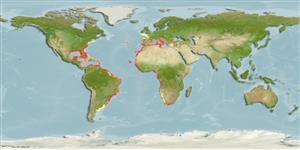Actinopterygii (ray-finned fishes) >
Perciformes (Perch-likes) >
Sparidae (Porgies)
Etymology: Pagrus: Greek, pagros = a fish, Dentex, sp. (Ref. 45335).
Environment / Climate / Range
Ecology
Marine; benthopelagic; oceanodromous (Ref. 51243); depth range 0 - 250 m (Ref. 3688), usually 10 - 80 m (Ref. 9626). Subtropical, preferred 24°C (Ref. 107945); 55°N - 43°S, 98°W - 36°E
Eastern Atlantic: Strait of Gibraltar to 15°N (rare southward 20°N), including Madeira and the Canary Islands; Mediterranean and northward to the British Isles. Western Atlantic: New York, USA and northern Gulf of Mexico to Argentina (Ref. 7251), including the continental coast of the Caribbean Sea (Ref. 9626).
Length at first maturity / Size / Weight / Age
Maturity: Lm 26.6, range 19 - ? cm
Max length : 91.0 cm TL male/unsexed; (Ref. 9710); common length : 35.0 cm SL male/unsexed; (Ref. 4781); max. published weight: 7.7 kg (Ref. 40637)
Dorsal
spines
(total): 12;
Dorsal
soft rays
(total): 10;
Anal
spines: 3;
Anal
soft rays: 8. Pinkish silver with an indistinct yellow spot on each scale on about upper half of body, these spots giving a yellow-striped effect; a wedge of yellow across interorbital and some yellow on snout and upper lip; dorsal, caudal and pectoral fins pink (Ref. 13442)
Found over rock, rubble, or sand bottoms (young frequently found on seagrass beds and the continental shelf (Ref. 47377)) down to about 250 m depth, often above 150 m. In southwest Brazil found in 160 m depth (Ref. 47377). Feeds on crustaceans, fishes, and mollusks (Ref. 3688). Its toxic nature is uncertain (Ref. 4690). Marketed fresh and frozen (Ref. 9987). Reported weights of caught individuals were between 9 to 17 kgs (9-10 off the west coast of Greece) (Hans Bollnert, hassebollnert@yahoo.gr, pers.comm. 12/09).
Protogynous hermaphrodite species. First sexual maturity occurs at 3 years of age (about 24 cm), first behaving as females and then as males. Spawning happens at 1 5-19° and it tends to be in spring,
depending on the habitat (in the Canary Islands it can start in January). Also Ref. 28504, 41163.
Bauchot, M.-L. and J.-C. Hureau, 1990. Sparidae. p. 790-812. In J.C. Quero, J.C. Hureau, C. Karrer, A. Post and L. Saldanha (eds.) Check-list of the fishes of the eastern tropical Atlantic (CLOFETA). JNICT, Lisbon; SEI, Paris; and UNESCO, Paris. Vol. 2. (Ref. 3688)
IUCN Red List Status (Ref. 115185)
CITES (Ref. 94142)
Not Evaluated
Threat to humans
Reports of ciguatera poisoning (Ref. 4690)
Human uses
Fisheries: commercial; aquaculture: commercial; gamefish: yes; aquarium: public aquariums
Tools
Special reports
Download XML
Internet sources
Estimates of some properties based on models
Phylogenetic diversity index (Ref.
82805): PD
50 = 0.5156 [Uniqueness, from 0.5 = low to 2.0 = high].
Bayesian length-weight: a=0.01349 (0.01216 - 0.01497), b=3.03 (3.00 - 3.06), in cm Total Length, based on LWR estimates for this species (Ref.
93245).
Trophic Level (Ref.
69278): 3.9 ±0.2 se; Based on diet studies.
Resilience (Ref.
69278): Medium, minimum population doubling time 1.4 - 4.4 years (K=0.13-0.27; tmax=11; tm=0.9-3.0).
Prior r = 0.48, 2 SD range = 0.27 - 0.86, log(r) = -0.73, SD log(r) = 0.29, Based on: 1 M, 12 K, 5 tgen, 1 tmax, 2 Fec records
Vulnerability (Ref.
59153): High to very high vulnerability (66 of 100) .
